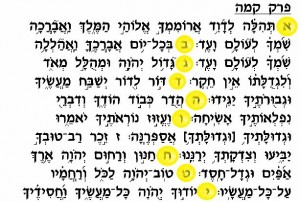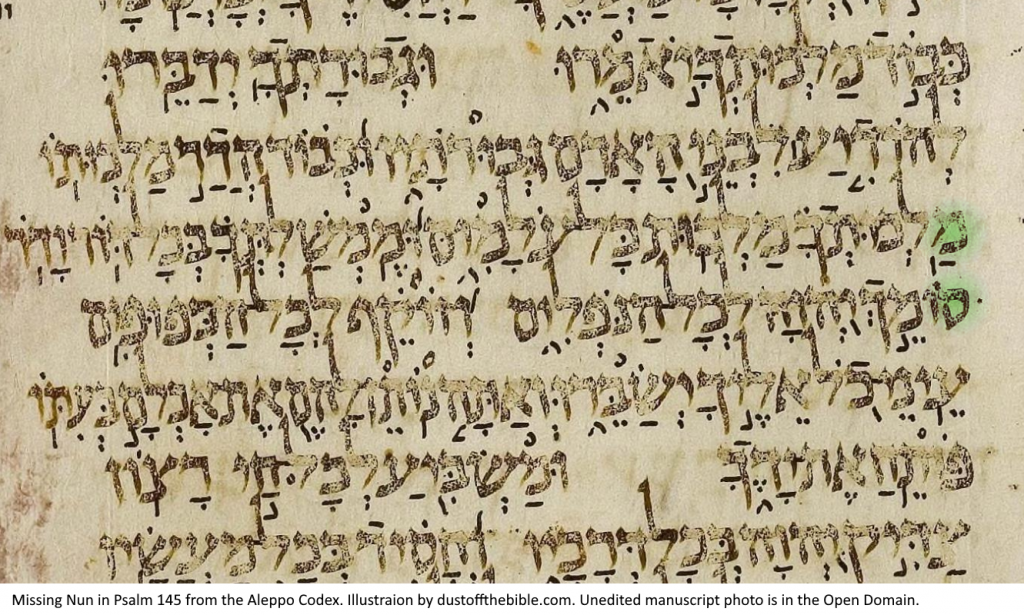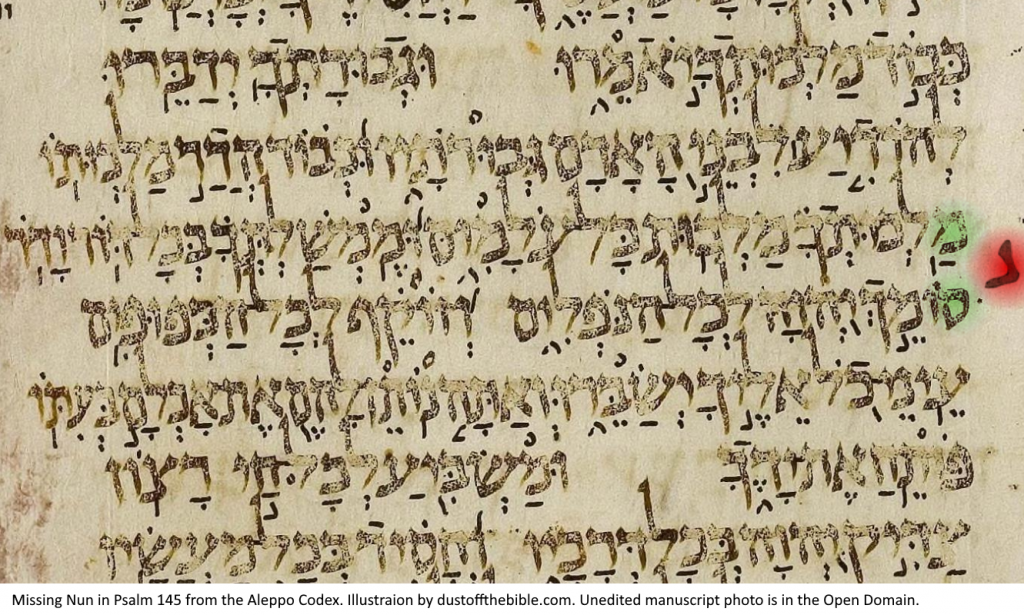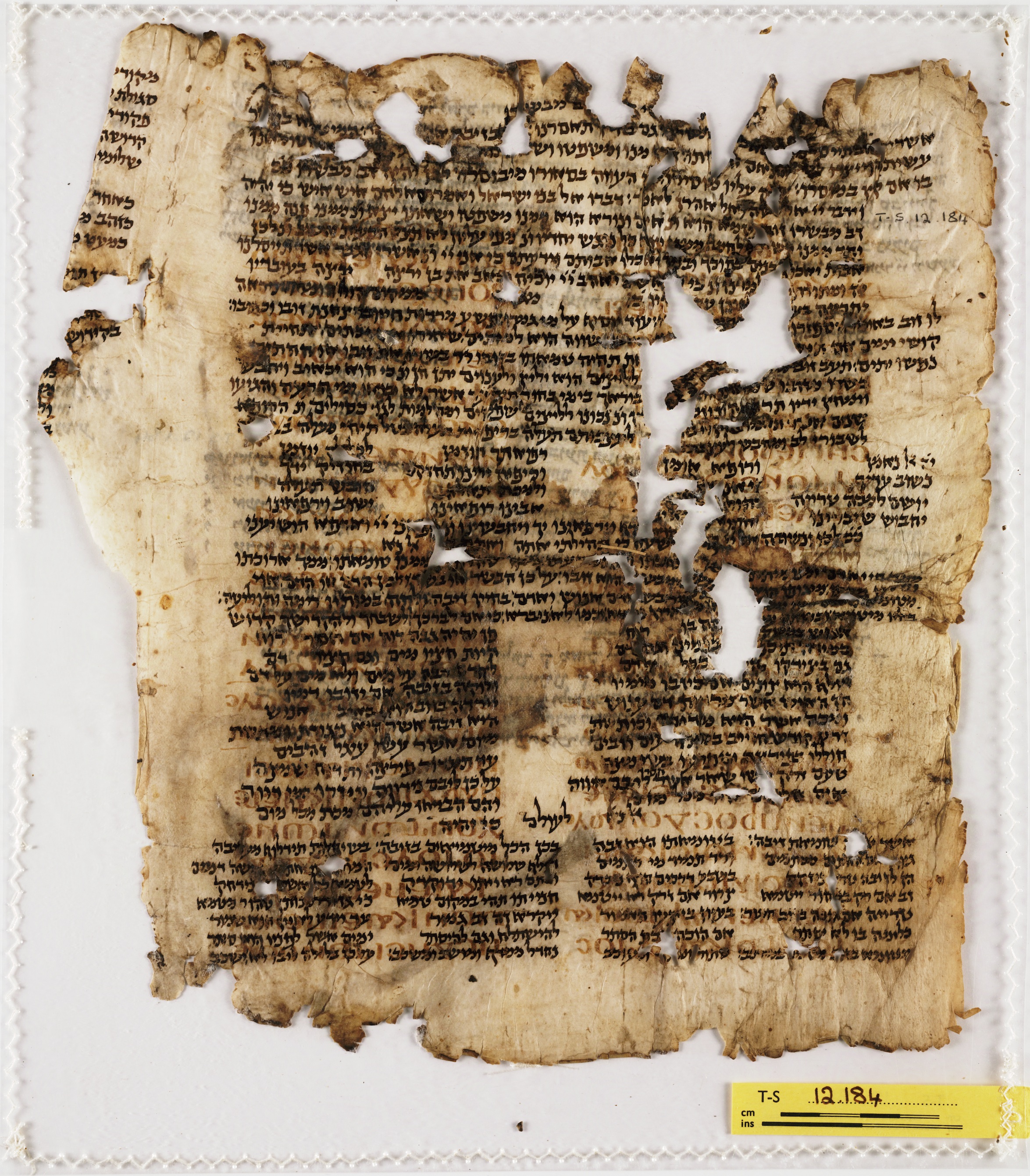Psalm 145 (Acrostic is missing the NUN)
An acrostic is an artistic way of writing by which each line or successive section of text starts with the next letter of the alphabet. A basic acrostic would look like this example.
- A – Another
- T – Translation
- E – Error

The difference between Hebrew and modern acrostics are that the Hebrew acrostics often use the letter to start a sentence, not just a word. Additionally, they usually include every letter of the alphabet.
The acrostic in Psalm 145 is composed with the entire alphabet minus one letter; the Nun. In other words, every letter in the alphabet was present, except one letter. The Hebrew acrostic sample from Psalm 145 is here to the left. Notice that each letter is represented as a single letter which makes it easy to follow.
However, in the case of the KJV and it’s underlying Hebrew text, the line beginning with Nun (Hebrew “n”) is missing.
That can be seen in the actual manuscript, below. Notice the letters circled in red and yellow. The red one is a Mem (“m”) and the yellow is a Samek (“s”). Between the two letters should be a line starting with Nun (“n”).

At first glance one might assume that perhaps the N is just placed out of order. But it does not appear anywhere else in the text as an acrostic form, only as part of a word. If a sentence starting with a Nun word was included, the Nun line would begin on an additional line, between the Mem and the Samek, as shown below.

How does one forget a Nun while doing an acrostic?
The simple answer to that question is that they would not forget the Nun. It was either left out on purpose, which is the view of many Jewish scholars, or it was mistakenly left out b a copyist, which is the view of the majority of paleographers. It is also the current view of the author of this article.
We must remember that many copyists did not actually know how to read and write. Not all manuscripts were copied by scribes. Scribes could read and write but a copyist sometimes only knew how to copy texts. This was almost better in some ways because they are not inclined to make purposeful alterations to the texts. However, it also means that they won’t be able to catch a mistake either.
Thus, at one point in history the manuscript source became this mistaken manuscript. Many scholars believe this happened around the 3rd century CE. Such an early mistake would almost ensure that once the error was copied a few times it would remain for centuries as the Hebrew language became less and less known. However, older Hebrew manuscripts as well as the Greek Septuagint and Latin Vulgate retain the missing verse. The Septuagint was completed about 132 BCE. The Latin Vulgate was done about 382 CE. Both sources used older manuscripts that still retain that missing verse.
Other places where the missing verse was included were in the Dead Sea Scrolls, and the Syriac Peshitta. One manuscript from the Dead Sea Scrolls clearly shows the verse with the Nun is retained, as in the image below. The 3 circles show the Nun retained between the Mem and the Samek.

Also note that some manuscripts are not aligned to emphasize the acrostic nature of Psalm 145. This manuscript from the Dead Sea Scrolls collection is a perfect example, as the letters are remarkably difficult to identify because each verse of the acrostic just continues after the previous. This is normal for older manuscripts. As time went on certain communities made alterations to the texts for readability as well as adding vowel markers which were done much later by the Masoretes. This text has no vowel markers and it even retains the older, proto-Semitic, alphabet letters from the Phonetician alphabet for the name YHWH.
It is clear that somewhere along the line the texts used for the KJV ended up omitting the verse with the Nun. Had the KJV used the older and more complete manuscripts they would have matched the other English translations that came later. To be fair, it’s not the fault of the KJV translators. It was the only manuscript available to the translators at the time. The Dead Sea Scrolls were not found yet and the Septuagint was not used very much anymore. One would think that they could have used the Latin Vulgate as a cross reference, since it had the missing verse but for some reason that did not occur to the translators.
In conclusion, the underlying manuscripts for the KJV are insufficient for Psalm 145. Thus, the claim that the manuscripts for the KJV were perfect and the others that were later discovered are corrupted is false. This will become more apparent as this series continues.

What did “Nun” mean?
Shirley, a “nun” is a Hebrew letter corresponding to the English “n”.